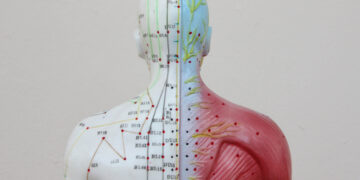The Body Speaks in Tension
There are days when you feel it before you even open your eyes—the tightness in your neck, the heaviness behind your eyes, the dull ache in your back from carrying more than your fair share. The body remembers. It holds what the mind cannot always process in the moment—stress, grief, overthinking, overstimulation.
When I first began exploring self-massage and acupressure during my training, I was struck by how immediate the effects were. A gentle press beneath the cheekbone softened my jaw. A few moments of firm pressure at the base of my skull cleared the fog in my head. With each breath, I was reminded: you don’t have to hold it all.
This practice is not about fixing or forcing. It’s about listening with your hands. Offering presence, not pressure. Releasing, not controlling.
Ad Banner #1
Placeholder for the first advertisement.
The Healing Wisdom of Touch
In both Eastern and Western healing traditions, touch has always held a central place in calming the body and rebalancing the nervous system. In Traditional Chinese Medicine, acupressure follows the same meridian pathways as acupuncture—those invisible rivers of energy, or qi, flowing through the body. Where there’s stagnation, there’s often tension. And with the right touch, that flow begins to return.
Self-massage and acupressure allow us to work directly with this tension, using our hands to soften muscles, soothe stress, and reawaken parts of the body that feel disconnected. The effects are both physical and emotional—because as we relax the body, the mind follows.
How to Begin: The Ground Rules
Before diving into specific points, it’s important to begin with a few foundational principles:
1. Less Is Often More
You don’t need to use intense pressure. In fact, too much force can overwhelm the nervous system. Think firm but compassionate.
2. Breathe With the Sensation
Pair your touch with slow, intentional breath. Inhale through the nose, exhale through the mouth or softly through the nose. This creates a rhythm that helps the body receive the pressure more fully.
3. Listen for Feedback
Your body will tell you when it’s enough. Tingling, warmth, or a gentle release are signs of energy moving. Sharp pain or increased tension are signs to ease off. Stay present and curious, not forceful.
4. Create a Calm Environment
Dim the lights. Play soft music if it helps. You don’t need a spa setting—just a moment of stillness and intention. This is your time.
Key Acupressure Points & Self-Massage Areas for Daily Release
✷ Third Eye Point (Yin Tang)
Location: Between the eyebrows, slightly above the bridge of the nose.
How to apply: Use your index or middle finger to press gently in small circles or stillness for 1–2 minutes.
Benefits: Eases tension headaches, calms the mind, supports sleep.
✷ Shoulder Nest
Location: The fleshy area between the neck and the top of the shoulder.
How to apply: Use opposite hand to gently squeeze or roll this muscle. Use slow, downward pressure and pause when you find a sore spot.
Benefits: Relieves upper body tension, helps release emotional weight held in the shoulders.
✷ Heavenly Pillar (on either side of the spine at the base of the skull)
Location: Find the two vertical muscles at the base of your skull, just an inch out from the centerline.
How to apply: Use your thumbs to press upward and inward. Hold for several deep breaths.
Benefits: Helps relieve neck tension, eyestrain, and mental fatigue.
✷ Chest Center (Sea of Tranquility / CV17)
Location: Midway down the sternum, between the nipples.
How to apply: Press gently with three fingers and breathe deeply. This point is very responsive to slow, steady breath.
Benefits: Calms anxiety, opens the chest, supports emotional release.
✷ Hands & Feet for Whole-Body Reset
Hand Point (LI4): Found in the webbing between thumb and index finger. Apply firm pressure for a few seconds at a time.
Foot Point (Kidney 1): Located on the sole, in the depression just under the ball of the foot. Use thumbs to apply firm, steady pressure while seated.
Benefits: Grounding, relieves tension throughout the body, stimulates energy flow.
Ad Banner #2
Placeholder for the second advertisement.
When to Pause and Seek Support
Self-massage and acupressure are gentle and supportive practices, but they are not a substitute for medical or therapeutic care. If you’re working with chronic pain, past trauma, or medical conditions—especially related to the circulatory or nervous system—move slowly and consult a qualified practitioner when needed.
Always avoid pressing directly on open wounds, inflamed areas, or broken skin. If you’re pregnant, some acupressure points (like LI4) may not be appropriate. Honor your body’s signals. Trust them.
A Practice of Coming Back
There’s something deeply intimate about learning to care for your own body through touch. These simple practices remind us that healing doesn’t always come from outside—it can begin with our own two hands, guided by breath and intention.
When we work with tension gently, with presence instead of punishment, we invite the body to speak—and more importantly, to release. These quiet moments become a form of meditation. A return to center. A way of saying: I’m here. I feel you. Let’s soften, together.
Your Invitation to Begin
Set aside five minutes today. Find a comfortable seat. Choose one point—perhaps the base of the skull, or the center of the chest. Breathe deeply. Apply gentle pressure. Stay present. Notice what shifts.
You don’t have to do it all. Just begin. Let the practice evolve with you. In time, these rituals become sacred—a conversation between your hands and your nervous system, your breath and your being.



























